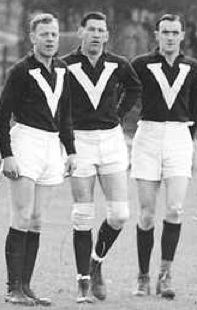Full name James William Park Original team(s) Bass Valley Date of birth 14 February 1910 Name Jim Park | Place of birth Bendigo, Victoria Weight 82 kg Place of death Wau, New Guinea | |
 | ||
Date of death 9 February 1943(1943-02-09) (aged 32) Role Australian Rules Footballer Died February 9, 1943, Wau, Papua New Guinea | ||
Education Scotch College, Melbourne | ||
James William Park (14 February 1910 – 9 February 1943) was an Australian rules footballer who played with Carlton in the Victorian Football League (VFL) during the 1930s.
Contents
He died in action, in New Guinea, whilst serving with the Second AIF.
Family
Born in Bendigo on 14 February 1910 to Alexander and Ethel Marion Park, he had three brothers, Alex, George, and Bob, and three sisters, Ethel, Hilda and Jean. His father was a general practitioner; and, in 1919, he moved his practice from Bendigo (having originally practised in Tatura) to Moonee Ponds in order to facilitate the education of his children: the boys attended Melbourne's Scotch College, which had not yet moved to Hawthorn and was still in East Melbourne, and the girls attended Melbourne's Presbyterian Ladies' College, also in East Melbourne.
He married Marjorie Jean Steele, and they had one daughter, Joan Millicent Park (later Mrs Schinner).
Education
He attended Scotch College from 1919 to 1926. He then went on to the Dookie Agricultural College, where he excelled in cricket, swimming, and football, as well as in his academic pursuits. In his second year he was dux of his class, and in his final year second only to the dux. He graduated from Dookie with a Diploma of Agriculture at the end of 1930.
Football
Recruited from Bass Valley Football Club, in Gippsland, he received his clearance to play with Carlton on 27 April 1932, and having played well for the Second XVIII on the preceding Saturday, he made his senior debut for Carlton at centre half-back, against Hawthorn, on 21 May 1932 (round four).
Park played in the back pocket and was a premiership player with Carlton in 1938, restricting prolific Collingwood forward Ron Todd to three goals.
In the same season he was chosen to represent Victoria for the first time in his career.
On Saturday, 28 May 1938, at Princes Park, in a match against Melbourne, which, although having more scoring shots, Carlton lost 14.18 (102) to 16.11 (107) — it was Carlton's first loss for the season — Park took one of the greatest marks of all time. Playing in the back pocket, in front of the Melbourne goal (having had only four yards of running space), he soared over the Melbourne forward Eric Glass, and held the mark. In the moment before the picture, Glass is erect, Park's left heel is at the level of Glass's left shoulder, his left knee is well above Glass's right shoulder, his right leg extended for balance, and the ball is a short distance away.
Military service
With his occupation listed as both "clerk" and "manager", Park enlisted in the Second AIF on 12 March 1941. On Tuesday, 18 March 1941, a senior team training night, Park attended Princes Park as a guest of the Carlton Football Club committee, and "was presented with a cheque in recognition of his services to the club in the last nine years".
In 1943 he was killed in action while fighting Japanese forces with the 2/6th Infantry Battalion at the Battle of Wau in New Guinea.
